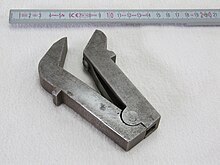Hoop block
A Reifkloben (or hoop iron ) is used for clamping flat workpieces. It is mainly used to bevel the edges of a workpiece with the help of a file .
Thin sheets are clamped together with a hoop by means of hoop clamps in a vice . The clamped workpiece was previously often an iron hoop , a tire , that is a metal strip, which as a tire of a wooden wheel as barrel hoops , or in the broader sense as fitting was used.
The hoop cock is sometimes also referred to as a hoop iron . Regionally, however, the term ripening iron means a draw knife for woodworking.
construction
It is made of two legs that are movably connected to one another, similar to a clamp, with one end each. The open ends of the legs are equipped with jaws that are parallel to each other, usually 45 ° to the leg axis , beveled.
use
To clamp the workpiece, it is placed in the jaws of the hoop, which is then pressed together by a vice and thus holds (clamps) the workpiece. This enables straight file guidance even when filing inclined surfaces on the edges, so-called chamfers .
The clamping range is limited due to the construction. The opening angle of the legs at the end of the jaw therefore only covers a certain range. Thus, different hoop blocks are necessary for workpieces of very different thickness.
Hoop clamps are used by locksmiths and mechanics , for example for processing metal strips, which are called hoops or tires and give a barrel cohesion or as the iron hoops of a wooden wheel. The hoop iron was an elongated iron plate, a tool that supported thin sheets of metal in the hoop block so that they could not bend.
